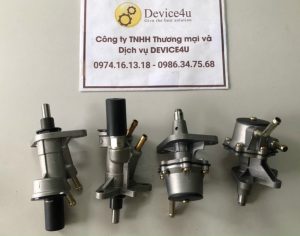Fuel transfer pump
1. What is a diesel fuel transfer pump?
Fuel pump or diesel fuel transfer pump is a type of pump used in the engine system to help stabilize the amount of fuel supplied to the system and hydraulic pump. The fuel transfer pump draws fuel from the tank. The tank must always be at least 2 to 3.5 times larger than the maximum amount of fuel supplied to the engine to keep the high-pressure pump operating normally even if the filter is damaged. dusty or have great resistance.

The diesel fuel transfer pump is driven from the high-pressure pump shaft or from the engine. Fuel pumps have many different types such as piston type, diaphragm type, gear type, rotor – vane type… The most commonly used type of fuel transfer pump is the double-acting piston type fuel transfer pump with automatic stroke change. piston. The pump also has a hand pump to release air before starting the engine. Piston pumps will suffer much less wear and tear than other types of pumps.
Structure: The low-pressure pump is usually installed on the casing of the high-pressure pump. The structure of a piston-type low-pressure pump includes a pump casing, roller shaft, spring, push rod, air cylinder, and closing and filling valves made of synthetic plastic.
2. Types of diesel fuel transfer pumps
2.1 Gear pump

Gear pumps are one of the most famous types of fuel transfer pumps used in hydraulic applications. Their vibration and noise will be higher than other types of pumps. This pump uses a gear mesh to pump, the fuel transfer pump sucks fuel from the tank through the displacement of liquid, oil, and fuel.
2.2 Submersible pump
This pump is a type of pump that transports liquid, fuel, and oil from underground tanks to storage tanks. Its limiting pressure is 50 PSI. It will not be suitable for low currents and small voltages of 120Vol.
2.3 Centrifugal pump

The centrifugal pump directs the fuel flow between cars in a bulk fuel tank vacuum state. The only limitation of this pump line is its poor suction power for liquids, oil, and fuel.
2.4 Diaphragm pump
Widely used in diesel fuel transfer pumps and most other liquids. The diaphragm pump will have high self-suction and self-priming capabilities and it is less likely to leak and has many other advantages.
3. Operating principle

When the cam returns to its neutral position, the spring expands and pushes the piston down, the volume of chamber A increases, the pressure decreases, the intake valve opens, then liquid and fuel will be filled into the chamber. (A), the volume of the tank (B) will decrease, the exhaust valve will close and the fuel available in the tank (B) will be pushed to the oil filter and high-pressure pump.
When the eccentric cam returns to its effective position, it pushes the lever up, the piston also goes up, the cavity volume (A) will now decrease, and at the same time the cavity volume (C) will increase, at this time the valve will The exhaust will open, the intake valve will close, the fuel will be in compartment (A) and pushed through the exhaust valve into compartment (B). The eccentric cam continues to rotate, the piston goes down and the fuel pumping process continues.
Working journey of fuel transfer pump:

When the eccentric cam stops acting on the roller, the spring will push the piston back to its original position, causing the volume in the suction chamber to increase and the pressure to decrease, causing the exhaust valve to close and the suction valve to open.
The fuel transfer pump will supply the system with the right amount of fuel regardless of engine speed.
If the working stroke of the piston remains constant, the pressure in the chamber is large enough to overcome the tension of the piston return spring, making it impossible for the spring to push the piston back to its original position. At that time, the stroke will be short and lead to reduced pump productivity and can easily lead to pump failure.
The fuel in the tank will be pumped into the tank, then the pressure difference will push the oil through the grooves to the exhaust valve and supply fuel to the system.
4. Where to buy a fuel transfer pump?
Currently, there are many units providing diesel fuel transfer pumps in the Hanoi market. When customers are looking for a reputable and reliable fuel transfer pump supplier, customers need to pay attention and carefully learn information about the supplier such as:
- Has many years of experience specializing in providing Deutz engine spare parts and forklift spare parts.
- The origin of spare parts is clear
- There must be a commitment to return and warranty if the goods have technical problems
- Enthusiastic customer support both before and after the sale.
The address specializing in selling diesel fuel pumps is Device4u Trading and Service Company Limited – specializing in providing Deutz engine spare parts and forklift spare parts nationwide.

With more than 10 years of experience in the forklift and forklift spare parts industry, we are committed to bringing you products of the right type, right quality and with clear origin. We have a well-trained technical team with many years of experience in the profession and were sent to the company for technical training, so they are very proficient in repairing and supporting customers with technical errors. technique during vehicle damage.
In addition, we also provide all forklift spare parts and air compressor spare parts. If you have any problem with your forklift that cannot be resolved, please contact us for the most enthusiastic answers and advice. To get a quote for fuel transfer pumps as well as other forklift spare parts. Please contact us via information:
DEVICE4U TRADING AND SERVICES COMPANY LIMITED
Address: Yen Vinh, Kim Chung Commune, Hoai Duc District, City. Hanoi
Phone: 0986.347.568 – 0974.16.13.18
Email: device4u.ct@gmail.com





